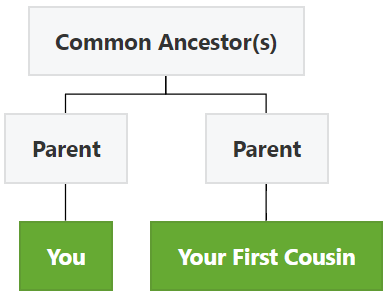Ever scratched your head trying to figure out exactly what a first cousin is? You’re not alone! In this article, we’ll dive into the fun and sometimes confusing world of family connections. We’ll break down the meaning of a first cousin, how they’re related to you, and even give you some real-life examples.
From there, we’ll explore whether first cousins are considered family (spoiler: they are), how they’re blood-related, and what grandparents you share. Want to know how many first cousins the average person has? We’ve got that too! And if you’ve ever wondered about second cousins, cousins “once removed,” and even what a half-first cousin is, we’ll cover all that as well. Join us as we explore the family tree together!
What is a First Cousin?
First cousins are individuals who have the same grandparents; the children of their parent’s siblings. Positioned two generations away from these shared grandparents, first cousins are part of the same generational tier. This familial connection fosters a closer bond than more distant relations, like second or third cousins.
Pro tip: Now that you understand first cousins, why not explore your family’s unique story? Try MyHeritage’s 14-day free trial to delve into billions of records and uncover your family’s tale. What stories await in your family tree?
A first cousin is related to another by sharing a set of grandparents. Second cousins share great-grandparents, and third cousins share great-great-grandparents and so on. First cousins are the children of their grandparents’ children so your aunts and uncles are the parents of your first cousins.

What is an example of a first cousin?
An example of a first cousin is as follows… your mother or father have siblings. If these siblings have offspring, their offspring are your first cousins. You are part of the same generation.
You share the same grandparent(s) and are often of a similar age.
Are first cousins considered family?
Yes, they are. Cousins, siblings, uncles, grandparents are all family. Cousins are usually considered to be close relatives, and second cousins are less so. Family members who are closely related share more of the same DNA, and first cousins are as close to your immediate family as can be. Other than siblings and parents, they are as close to immediate family as possible.
In terms of the law, first cousins are often considered close family. In the USA, first cousins are often thought of like family for legal purposes to do with funerals and even commercial contracts so it is best to check with your state authority if you need clarification.
In society, a lot will depend on what constitutes a family. It may be the case that only close family are invited to a wedding, but some people have a different take on what qualifies as close, so first cousins may or may not receive the invite.
Immediate family does not usually indicate first cousins, but close family may be a better way of describing the relation.
First cousins are blood relatives when you share a common ancestor(s). This is for either the maternal or paternal side, as the children of your uncles and aunts are your first cousins. Only adopted members of the family are not blood relatives.
Another example is if a cousin is a relation through marriage, then they are not blood relatives. If your aunt married a man who had a child from their prior relationship then you may call this child your cousin and grow up knowing them as your cousin, but they are not blood relatives.
The amount of DNA that first cousins share can vary from around 7% to 13.8%. On average, first cousins share around 12.5% DNA. This figure is the result of different inherited amounts of DNA, also from common ancestors. For example, one cousin will receive different sections of DNA from a grandparent than another. Each generation the DNA is passed down to decrease the amount of DNA found.
Can first cousins marry?
The question of whether first cousins can marry is subject to legal, cultural, and sometimes religious considerations. In some regions and cultures, marriage between first cousins is perfectly legal and accepted, while in others, it may be prohibited or frowned upon. The differing views on this issue often stem from concerns related to genetics, social norms, or specific religious teachings. Therefore, understanding the legality and acceptance of first cousin marriage requires a consideration of the local laws and cultural context where the individuals reside.
In the context of genealogy, it’s noteworthy that marriage between first cousins was historically more common in many societies. Such marriages were often arranged for various reasons, including maintaining family wealth, strengthening political alliances, or preserving social status within a community.
First cousins share at least one grandparent. Second cousins share a great-grandparent, third cousins share a great-great-great-grandparent, and so on. The cousinhood degree of first, second, third, fourth, fifth, etc indicates the number of generations between the parents of any two cousins.
As the children of siblings, first cousins always share a mutual grandparent.
How many first cousins does the average person have?
This will depend on how many children your uncles and aunties have. In the past, it was not unusual for families to have close to ten children, sometimes more. This means if your grandparents had ten children, these siblings could go on to have multiple children, increasing the number of first cousins you have.
Birth rates are an important part of predicting the number of first cousins anyone can have. Even if yours has an average of 5 first cousins per family, this doesn’t mean you will necessarily be close to that figure.
Understanding Different Types of Cousins
Family relationships can be complex, especially when it comes to cousins. While most of us are familiar with the term ‘first cousin,’ the definitions and relationships extend beyond this. In this section, we’ll unravel the distinctions between other types of cousins and explore the intricate connections that bind family members.
What is a second cousin?
A second cousin is the child of your parent’s first cousin, meaning they share a set of great-grandparents. While first cousins are one generation away from each other, connected through their grandparents, second cousins are two generations apart, connected through their great-grandparents. Both these terms, “first cousin” and “second cousin,” are used to describe specific familial relationships that are dictated by the generational separation between family members.
What does once removed mean?
The “once removed” designation signifies a difference of one generation. For example, your first cousin’s child would be your first cousin once removed. Here, the term “first cousin” refers to the common grandparent that you share, and “once removed” indicates a one-generation difference between you and your first cousin’s child. Similarly, your parent’s first cousin would also be your first cousin once removed. In both scenarios, the connection is still through the shared grandparent, but the “once removed” notes the generational gap.
What is first cousin once removed?
First cousins not in the same generation are likely to be once removed. The child of a first cousin is known as a first cousin once removed.
So, you are the first cousin once removed from the first cousin of your parents. Your common ancestor is your great-grandfather. This means you are first cousins but with a generation between you. Therefore, you are first cousins once removed. The number of times you are removed from a cousin is in the number of generations that separate you.
What is my cousins kid to me?
Your cousin’s child would be your first cousin once removed. This term defines the relationship by identifying the generational difference between you and your cousin’s child. While you and your cousin share a set of grandparents, making you first cousins, the child is one generation removed from that relationship
What does first cousin twice removed mean?
Twice removed means there is a difference of two generations between two relatives, A first cousin twice removed will be your grandparent’s first cousin or your first cousins’ grandchild. The two generations between you and your grandparent’s first cousin, and your first cousin’s grandchild is an indication of this.
What is a half-first cousin?
Half-first cousins are individuals who share only one grandparent, unlike full first cousins who share a full set of grandparents. This relationship arises when two half-siblings each have children.
Here’s an example to illustrate the concept of half-cousins:
- Person A and Person B are half-siblings, meaning they share one parent (let’s say, a mother) but have different fathers.
- Person A has a child, Child A, and Person B has a child, Child B.
- Child A and Child B are half-first cousins because they share one grandparent (the mother of Persons A and B) but not both grandparents on that side of the family.


Hello Marc,
I have been going over my family tree and using digitalarkivet to confirm that the relatives in my tree are who their suppost to be. The situation is I had taken a DNA test with 23&Me and Ancestry and found that I have a 1st cousin that I never knew anything about him. I was able to contact this 1st cousin and we exchanged family relative information. I built my 1st cousin’s tree and also used digitalarkivet to confirm his families information. So 23&Me sent me a diagram not using names of how myself and 1st cousin connect but I have no idea how to connect the dots. I don’t want to post my name along with my relitives on this platform but I can give you centimeter and pecentiles of our DNA readings. So my Dna is 931 cM | 13% shared DNA and my 1st cousin’s DNA is the same 931 cM | 13% shared DNA. 23&Me sent me a diagram that shows a relationship with out names.
Who can I have to look at all this information in order to give me an idea about which people that myself and my 1st cousin connect to.
Thank you much
You would need to look at your shared matches to see which side of your tree they most likely fit.
why is it that so many get the terms first cousin once removed and second cousin confused with each other if people would stop and think about how people fit in their family tree they wouldn’t be confused about family relationships
Sorry. To correct myself, I meant to say “down to Lucia Franklin, our 3x great grandmother”
So, what does all this mean TO ME? In tracing my roots through FamilySearch.org, I discovered that my brotherr, sister and I are “first cousins, eight times removed” of Benjamin Franklin – THE Benjamin Franklin. So, what would be the percentage of shared DNA between us and him (if any}? (For context, Benjamin Franklin’s grandfather, Benjamin Thomas Franklin, is our 10x great grandfather, another of his sons, Benjamin Franklin (a different one) is our 9x great grandfather, and so on, down to Keziah Franklin, our 5x great grandmother.) Is it possible to calculate shared DNA, in such a case?
Hey James. If my math is correct, you would share (in theory) ~0.05% DNA. In practice, probably zero would be detected. Hope that helps!